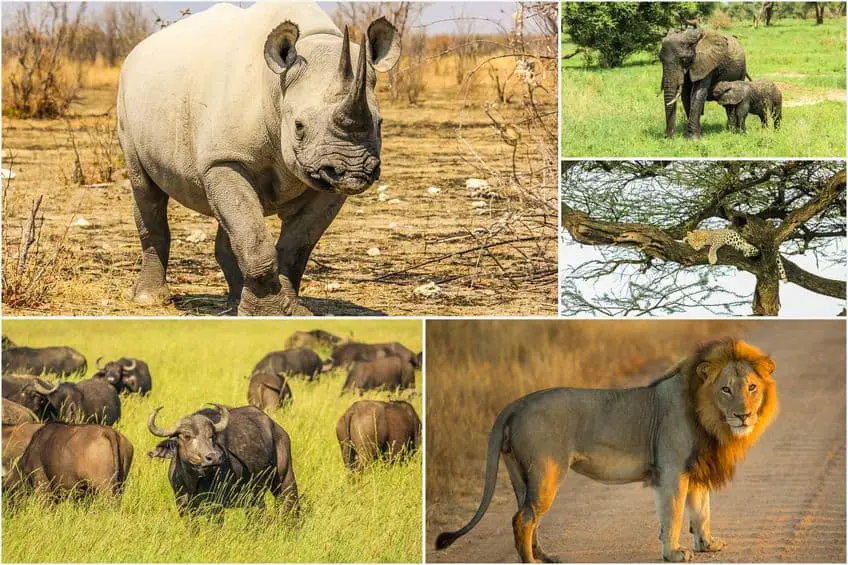
The big five is a legendary group of African wildlife that thousands of safari tourists hope to see every year. The five members of the group are Cape buffalos, elephants, leopards, lions, and black rhinoceros. They are some of the most iconic and well-known African animals and there are countless incredibly interesting and captivating facts about them.
This post covers more than 260 fascinating, surprising, strange, fun, and unbelievable facts about Africa’s big five.
Cape Buffalo – Syncerus caffer
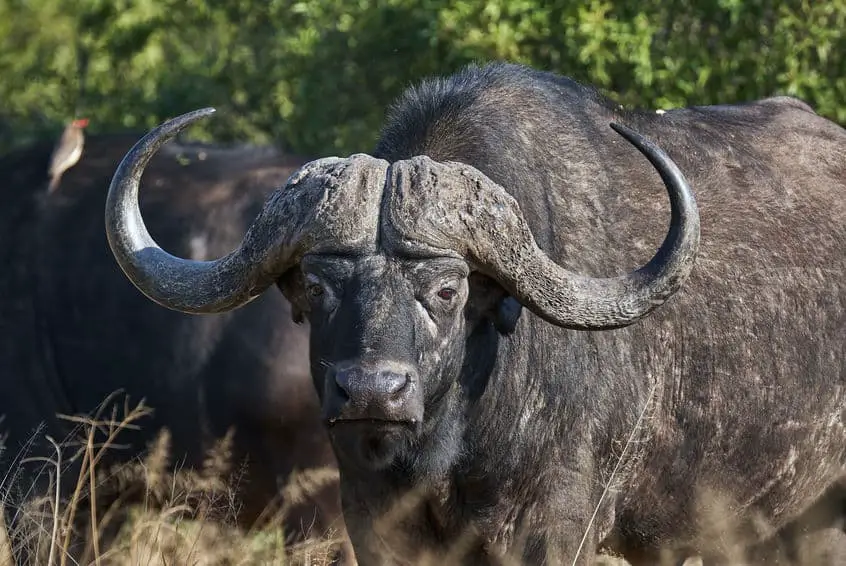
Cape buffalos, or African buffalos, are very large and incredibly strong animals that can be extremely dangerous. They are beautiful and mesmerizing creatures in many ways and there are numerous fascinating facts about them.
Below, you can find 50 interesting, captivating, fun, and even strange facts about Cape buffalos.
General Cape Buffalo Facts
- Cape buffalos belong to the Bovidae family of animals.
- A male Cape buffalo is called a bull and a female is called a cow.
- Cape buffalos are herbivores and their diet consists almost entirely of grass.
- Cape buffalos are known for being unpredictable and aggressive.
- Cape buffalos are often referred to as Black Death or Widowmakers. (Read more).
Facts About Cape Buffalo Appearance And Anatomy
- Male Cape buffalos weigh 1100-2000 pounds (500-900 kg) and females weigh 770-1365 pounds (350-620 kg). (Read more).
- Cape buffalos can be up to 5.7 ft (175 cm) tall.
- Cape buffalos can run 35 mph (57 kph).
- Male Cape buffalos are slightly darker than females.
- A darker color is associated with dominance for male Cape buffalos.
- Male Cape buffalos spend large amounts of time rolling around in the mud to become darker.
- Male Cape buffalos have thicker necks and shoulders than females.
- Male Cape buffalos have thicker horns than females.
- Female Cape buffalos have longer horns than males.
- The largest Cape buffalo horn ever on record measured 64 inches (163 cm). This record belongs to a female.
- Male Cape buffalos’ horns meet in the middle and form a rock-hard and thick area called a boss.
- The boss on a male Cape buffalo is so thick that it can stop bullets.
Facts About Cape Buffalo Habitat
- Cape buffalos can be found all over sub-Saharan Africa.
- Cape buffalos can live in many types of habitats and are mostly found in savanna, wetlands, shrubland, grassland, forest, and desert.
Facts About Cape Buffalo Conservation
- The conservation status of Cape buffalos is Near threatened.
- There are 398,000 to 401,000 Cape buffalos left in the wild in Africa according to IUCN.
Facts About Cape Buffalo Life Cycle
- Cape buffalos have a lifespan of 22 years in the wild but a life expectancy of just 11 years. They have a lifespan of 29 years in captivity. (Read more).
- Cape buffalos reach sexual maturity around the age of 3 to 5 years.
- The gestation period for female Cape buffalos is 11-11.5 months.
- Female Cape buffalos give birth to 1 calf at a time.
- Cape buffalo calves weigh 66 to 132 lb (30 to 60 kg) at birth.
- Female Cape buffalos raise the calves. The males generally do not invest time or energy in the calves.
- Sometimes female Cape buffalos can adopt calves that have lost their mother.
Facts About Cape Buffalo Herds
- Cape buffalos are highly social creatures that usually stay together in groups of 15-20.
- A group of Cape buffalos is called a herd.
- A herd of Cape buffalos consists of a large group of females that are related to each other, their calves, and a smaller group of males.
- The female Cape buffalos in a herd decide which way the herd moves.
- Male Cape buffalos fight each other to establish dominance in the herd.
- The dominant male Cape buffalo will be more attractive to the females.
- Cape buffalo herds can have up to 3000 members. These herds are temporary and mostly occur during mating season and for long walks.
- Male Cape buffalos that are too old to produce offspring sometimes leave their herd and live on their own or form small male herds with other old bulls.
Facts About Cape Buffalos And Natural Enemies
- Lions are the most common natural enemies for Cape buffalos. (Read more).
- Cape buffalos are so strong that they can use their horns to throw a lion several meters through the air.
- Cape buffalos are great at defending each other and will come and help if a member of their herd is under attack by a predator. When one Cape buffalo attacks, the rest will usually follow.
- Cape buffalos can use their horns to impale enemies.
- In some regions of Africa, Cape buffalos make up the majority of lions’ food.
- Cape buffalos have been observed systematically seeking out and killing lion cubs.
- Fully grown Cape buffalos have thick and dense ribs that almost work like armor that protects the chest and organs.
- The most common cause of death in Cape buffalos is disease. Cape buffalos live in dense herds so diseases can spread rapidly.
Facts About Cape Buffalos And Humans
- Cape buffalos are considered to be the most dangerous of the big five. (Read more).
- It is estimated that Cape buffalos are responsible for around 200 human deaths per year.
- Cape buffalos are thought to have killed more big-game hunters than any other African mammal.
- If a hunter escapes an attacking Cape buffalo by climbing up into a tree, the Cape buffalo can wait underneath the tree for several hours to get revenge.
- Cape buffalos can sneak around a hunter and charge from behind.
- Cape buffalos do not mock charge. Once they charge, they will try to kill their target.
If you find Cape buffalos interesting and you want to learn more about them, I recommend heading over to this page where you can find all our posts about Cape buffalos.
African Elephant – Loxodonta africana
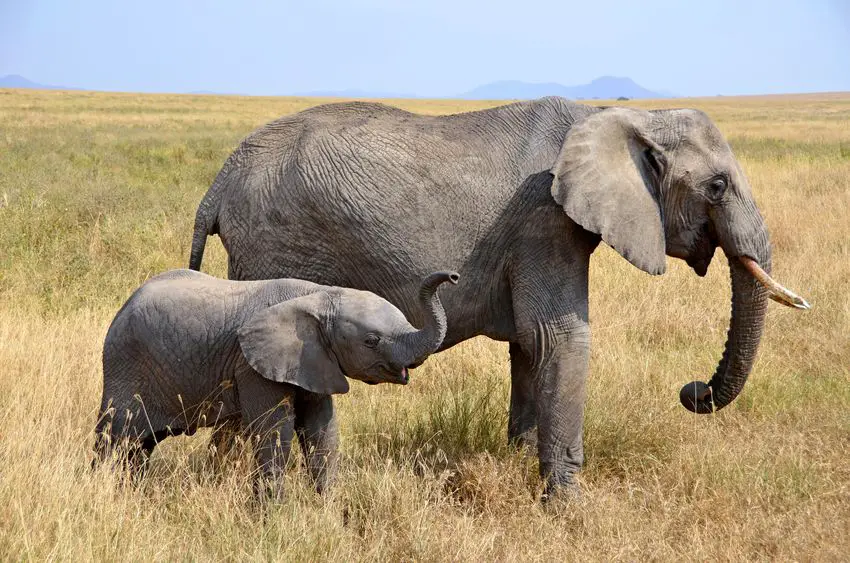
African elephants are some of the most well-known and beloved animals in Africa and thousands of safari tourists go to Africa every year hoping to see them and that is for a very good reason. African elephants are some of the most unbelievable and magnificent animals in the entire world and there are tonnes of fascinating and surprising facts about them.
Below, you can find 62 of the most interesting and fun facts about African elephants.
General Facts About African Elephants
- Elephants can produce sounds that are so deep that humans can’t hear them. These sounds can be heard by other elephants several miles away and are used to keep each other oriented about where they are.
- African elephants can feel small vibrations in the ground with their feet and know about incoming thunder, which often means rain and therefore fresh, green vegetation.
- African elephants use their ears to cool down. They have a large number of blood vessels in their ears and when they wave them, some of the heat from the blood is carried away.
- A common cause of death for African elephants is that their teeth become so worn out after years of chewing tonnes of plants that they lose their ability to chew food and thereby obtain nutrients.
- African elephants are the largest land-living animals in the world.
- African elephants belong to the Elephantidae family of animals.
- African elephants can run 25 mph (40 kph).
Facts About African Elephant Appearance And Size
- An African elephant’s heart can weigh up to 62 lb (28 kg).
- An African elephant’s canine teeth can weigh almost 9 lb (almost 4 kg) each.
- The largest elephant tusk ever on record weighed 287 lb (130 kg) and measured 10.76 ft (328 cm) in length.
- Male African elephants weigh 8,800-14,300 lb (about 4,000-6,500 kg) and females weigh 8,800-14,300 lb (about 4,000-6,500 kg).
- African elephants can be up to 13.1 ft (4 meters) tall.
- African elephants can get up to 24 ft (7.3 meters) long.
- African elephants’ tails are 3.3-5 ft (1-1.5 m) long.
Facts About African Elephants’ Social Structure
- A group of elephants is called a Herd.
- Female African elephants are social creatures that usually stay in groups of 10-12.
- The females in a herd are usually related to each other and usually include mothers, grandmothers, aunts, cousins, sisters, and calves.
- Fully grown male African elephants are typically solitary animals but can sometimes stay in temporary groups with other males.
- Female African elephants stay in their herd for their entire lives.
- Male African elephants leave their herd when they reach adolescence.
- Young males that have left their herd will often seek out other young males and form temporary groups of up to 100 male elephants.
Facts About African Elephants’ Life Cycle And Offspring
- African elephants have a lifespan of 70 years in the wild and 17 years in captivity.
- The life expectancy of African elephants is 50-65 years depending on the region. (Read more).
- There are 3 stages in the life cycle of an African elephant; the baby stage (lasts until age 5-10), adolescence (lasts until age 18-20), and adulthood. (Read more).
- The gestation period of African elephants is 21-22 months.
- African elephants almost always have 1 calf but can have twins about 1% of the time. (Read more).
- African elephant calves weigh 200-265 lb (90-120 kg) at birth.
- African elephant calves are covered in long hairs all over their bodies that serve the purpose of carrying heat away from the calves’ skin to help them stay cold and not overheat.
- African elephant calves begin to learn to walk within a few hours of being born.
- Young African elephant calves are clumsy and sometimes trip and fall over their own trunk.
- Newborn calves drink around 4 gallons (15 liters) of their mother’s milk every day.
- Calves grow by around 2.2 lb (1 kg) per day.
- The tusks begin to appear within the first year of an African elephant’s life.
- If a calf loses its mother, another female elephant from its herd can adopt it and raise it as if it was her own.
- African elephants reach sexual maturity around the age of 10-13.
- Male African elephants from around age 25 and up will occasionally come into musth. When they are in musth, they have only one focus; seeking out females for mating.
- During musth, male elephants’ testosterone levels are much higher than normally and they become much more aggressive.
Facts About African Elephants’ Habitat And Diet
- African elephants are herbivores that eat branches, grass, bark, berries, fruits, and other plants and with such a diverse diet, they can also live in many types of habitat.
- The primary habitats of African elephants are savanna, forest, grassland, shrubland, wetlands, and deserts.
- African elephants can be found in most sub-Saharan African countries.
- African elephants eat for up to 16 hours per day.
- African elephants can consume plants equal to up to 5% of their body weight per day. For the large bulls, this amounts to 660 lb (about 300 kg) of plants per day.
- African elephants drink around 42 gallons (160 liters) of water every day.
Facts About African Elephants’ Natural Enemies
- Fully grown elephants have very few natural enemies because of their size, strength, and thick skin. (Read more).
- Mostly calves, young elephants, and very old, sick, or otherwise weak elephants are at risk of being hunted by predators.
- The primary natural enemies of African elephants are lions and humans.
- Sometimes smaller predators such as hyenas, African wild dogs, and crocodiles can try to kill a small elephant calf.
- When a herd of elephants is under attack from predators, they will form a defensive circle with the strong elephants on the outside and the young or weak on the inside for protection.
Facts About African Elephants Conservation
- The conservation status of African elephants is vulnerable.
- There are around 415,000 African elephants left in the wild according to IUCN.
- According to WWF, tens of thousands of elephants are killed by poachers every year.
- The overall population of African elephants is increasing, mostly in the southern regions of Africa.
Facts About African Elephants’ Tusks And Trunks
- Male African elephants generally have larger tusks than females.
- African elephants use their tusks for debarking trees, moving things around, and digging for water. (Read more).
- African elephants can also use their tusks for combat and self-defense by trying to impale attackers.
- The tusks on an African elephant can grow up to 6.7 in (17 cm) per year.
- The largest tusk from an African elephant ever measures was 10.76 ft (328 cm) long and weighed 286 lb (130 kg).
- An African elephant’s tusks grow for the elephant’s entire life.
- African elephants are left or right-tusked, just like humans are left or right-handed. The dominant tusk is often slightly shorter than the other one due to wear and tear.
- African elephants use their trunks to break branches and pick leaves to eat.
- African elephants can lift up to 1100 lb (500 kg) with their trunks.
- There are more than 100,000 muscles in an African elephant’s trunk.
If you like these facts and you are curious about African elephants and want to learn more, head over to this page where you can find all our posts about them.
Leopard – Panthera pardus
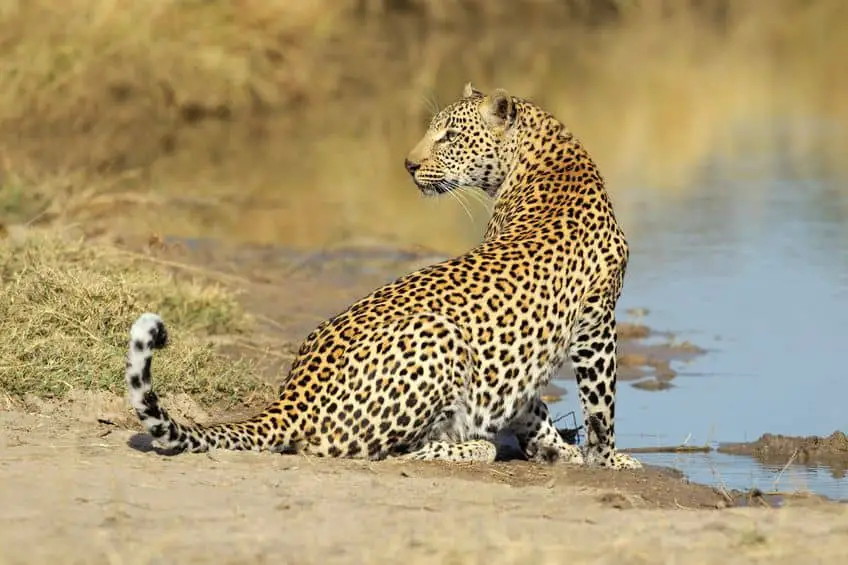
Leopards are true masters at hunting where they rely on a deadly combination of stealth and strength. It is not without reason that they have often been referred to as Africa’s most efficient hunter. Leopards are also extremely elusive animals and despite being widely distributed all over sub-Saharan Africa, they require patience, luck, or skill to see.
These are just a few of the many mesmerizing, fascinating, and fun facts about leopards that are covered below.
General Leopard Facts
- Leopards belong to the Felidae family.
- Leopards can sometimes be born as black panthers. Black panthers are not a distinct species but a genetic variation that can occur in many types of cats. (Read more).
- The last sighting of a black leopard (panther) in Africa happened in Kenya in 2019. The last confirmed sighting before that happened 110 years before that.
- Leopards are the smallest member of the big five.
- Leopards are solitary creatures.
- A group of leopards is called a leapbut leopards are only seen in leaps when a mother is with her cubs.
- Leopards are nocturnal which means they are active at night. (Read more).
- Leopards are highly territorial animals.
- Male leopards have much larger territories than females. One male territory can contain up to 6 female territories.
- Leopards of the same sex can have overlapping territories but will not use the shared part of their territories at the same time.
Facts About Leopard Appearance And Anatomy
- Leopards are dense, bulky, muscular, and front-heavy animals. Their heads are large, their necks and jaws are muscular and extremely strong and their eyes have a yellow and sometimes almost green color.
- Leopards have retractable claws that are excellent for climbing and hunting. When leopards relax, their claws are retracted.
- Male leopards are slightly larger than females.
- Leopards usually weigh between 44-66 lb (25-30 kg) but the size varies a lot from region to region and depends mostly on the prey the leopards can hunt in their territory.
- The largest male leopards can weigh up to 200 lb (91 kg).
- Leopards can run 37 mph (60 kph).
- A leopard’s tail is almost as long as its body. The tail is used for balance and navigation when running and climbing trees.
- Leopards’ front paws are larger than their back paws to support their heads while carrying heavy prey in their mouths.
Facts About Leopard Distribution And Habitat
- Leopards can be seen in most of sub-Saharan Africa.
- Leopards are native to more than 35 African countries.
- Leopards thrive in many types of habitat and are most often seen in savannas, forests, shrublands, and grasslands but can also be seen in deserts and mountains.
Facts About Leopard Conservation
- The conservation status of leopards is ‘vulnerable’.
- There are roughly 700,000 leopards left in the wild in Africa.
Facts About Leopards Life Cycle And Offspring
- Leopards have a lifespan of 17 years in nature and 23 years in captivity. (Read more).
- The life expectancy of leopards in the wild is 10-12 years.
- Female leopards raise cubs alone.
- Female leopards can mate upwards of 100 times in a day when they are in heat.
- Male leopards are known to seek out and kill leopard cubs to prevent future competition.
- Female leopards will mate with more than one (typically 2-3) males when they are in heat. They do this since male leopards won’t kill cubs from females they have mated with.
- Female leopards have a gestation period of 90-110 days.
- Female leopards usually give birth to 1-4 cubs at a time but sometimes up to 6.
- Leopard cubs weigh 1 to 1.3 lb (450 to 600 gr) at birth.
- Leopards are born with closed eyes. Their eyes open after about a week.
- Leopard cubs are born with grey fur that slowly turns into the characteristic yellow and orange coat with the well-known dark, circular markings over the first few weeks and months of the cubs’ lives.
- Female leopards with newborn cubs will move around every few days for the first 6 weeks of the cubs’ lives to prevent predators from finding and killing them.
- Leopard cubs drink their mother’s milk for the first 3 months of their lives after which they begin to add meat to their diet.
- Leopard cubs practice their sneaking skills by sneaking up on and jumping on each other.
- When leopard cubs are about 3 months old, they will follow and try to imitate their mother when she is hunting to practice their own hunting skills.
- Around the age of 2, leopards will leave their mother and go out and live solitary lives.
- Leopards reach sexual maturity around the age of 2-4 at which point they will begin to look for a suitable mate to produce offspring of their own.
Facts About Leopards’ Hunting And Eating Behavior
- Leopards rely on stealth and camouflage when hunting. (Read more).
- Leopards usually sneak up on their enemies and get within just 15 ft (about 5 m) before they strike.
- Leopards have whiskers on their legs and face that are extremely sensitive to any touch.
- Leopards have some extra sensitive hairs all over their fur that give them complete awareness of their entire bodies.
- Leopards’ night vision is 7 times stronger than humans’.
- Leopards can eat over 100 different species of animals ranging from beetles and frogs to young giraffes and zebras.
- The preferred prey for leopards is medium-sized antelopes such as impalas and springboks.
- Leopards are excellent climbers and are strong enough to carry prey high up into trees. (Read more).
- Leopards often carry their food high up into a tree to secure it from larger predators.
- Leopards utilize their ability to climb to escape predators that are chasing them.
- Leopards do not have many natural enemies but lions, hyenas, and African wild dogs can sometimes chase leopards to steal their food and will sometimes try to kill them.
If you liked these facts and want to read more about leopards, go to this page where you can find all our posts about leopards.
Lion – Panthera leo
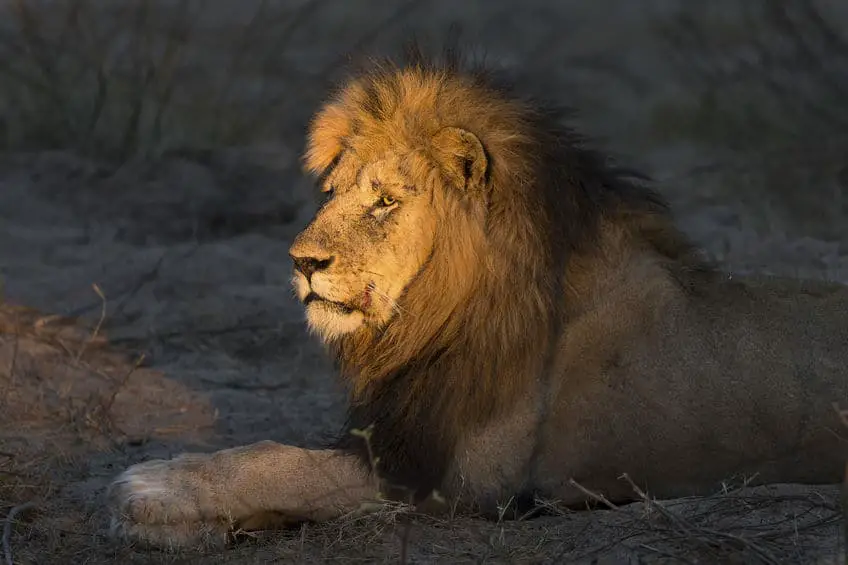
Perhaps the most iconic and well-known of all African animals, lions are truly majestic and powerful creatures and there are so many fascinating, exciting, mesmerizing, and fun facts about them that you should know so I have collected 64 of the most interesting and surprising facts about lions.
Facts About Lions’ Sleeping Behavior
- Lions sleep upwards of 20 hours per day and are often seen resting or sleeping in the shadow of a tree or some bushes. (Read more).
- Male lions usually sleep more than females. The reason for this is that the females generally spend more time hunting and taking care of cubs.
- Lions prefer to rest near waterholes. Especially on warm, sunny days where they need easy access to water.
- Lions are considered to be nocturnal but many sources also categorize them as crepuscular. This means that they are active primarily in the twilight period which is the time period between dawn and sunrise or between sunset and dusk. (Read more).
- One of the primary reasons why lions sleep as much as they do is to optimize the preservation of energy for the night as they need it for hunting.
Facts About Lion Distribution And Habitat
- Lions can be seen in most of sub-Saharan Africa.
- The largest populations of lions are found in South Africa, Botswana, Kenya, Tanzania, Zambia, and Zimbabwe.
- Lions have often been referred to as the king of the jungle but lions do not actually live in jungles.
- Lions can live in many types of habitats including savanna, grassland, forest, shrubland, and desert.
Facts About Lions’ Social Structure
- Lions are social creatures that mostly stay together in groups.
- A group of lions is called a pride.
- A pride of lions can consist of anywhere between 3-40 lions. The largest prides are usually found in the eastern parts of Africa for instance in Kenya and Tanzania.
- A pride of lions is made up of a large group of females that are usually all related to each other, their cubs, and a small group of males.
- When male lions reach the age of 2-4, they leave their pride and become nomads until they are large and strong enough to claim a territory and a female pride of their own.
- Female lions stay in the pride they were born in for their entire lives.
- The female lions in a pride stick together for their entire lives. The males come and go every couple of years.
- The lionesses are the primary hunters in a pride. Male lions will generally only hunt if they have to.
- Lions are highly territorial animals. A female pride can keep the same territory for decades and many generations.
Facts About Lions’ Life Cycle And Offspring
- The lifespan of lions in the wild is 16 years for the males and 18 years for the females. The lifespan of lions in captivity is 30 years.
- The average life expectancy of lions in the wild is 12 years for the males and 15 years for the females.
- The gestation period of female lions is 3.5-4 months.
- Lionesses usually give birth to 1-4 cubs but sometimes up to 6.
- Lion cubs weigh 2-4 pounds (1-2 kg) at birth.
- Female lions raise and take care of the cubs with help from the other females in their pride. The males generally do not help much with raising the cubs.
- Lion cubs drink milk from their mother for the first 6-7 months of their lives since it is full of nutrients that will help them grow and become strong.
- Lion cubs will begin to add meat to their diet after around 2-3 months.
- At the age of 6-7 months, lion cubs’ diet will consist of meat just like the fully grown lions.
Facts About Lions’ Hunting Style And Diet
- Lions are large and heavy cats that cannot run fast for a long period of time so they have to make their kill fast. (Read more).
- Lions usually hunt at night or in the very early morning or late evening.
- Lions rely on stealth and their ability to sneak up on animals when they hunt since much of their usual prey animals can actually run faster than the lions. This is also one of the reasons, why hunting at night is so beneficial for lions since most of their preferred prey is resting or sleeping.
- Lions burn excessive amounts of energy when they run and hunt so by hunting when it is dark, they preserve much more energy since it is colder and since most of their preferred prey are not active at night and are therefore easier to hunt.
- On rare occasions, lions can be seen hunting during the day. They will almost only do so if the weather is cloudy or cold since warm and sunny weather is too energy-consuming for them.
- Lions have excellent eyesight in low-light conditions which gives them a big advantage over their prey.
- Male lions make sure that they get to eat first and will usually not let anybody near the food before they are full.
- If a pride of lions has killed a large animal that contains plenty of food for the whole pride, the males will sometimes let the lionesses and the cubs eat right away.
- Lionesses almost always let the cubs eat first.
- Lions can sometimes go for 4-5 days without eating.
- Lions can consume food equal to 20% of their body weight. For the largest males, that means 110 pounds (50 kg) of food at the same time.
- In addition to hunting, lions often scavenge a large portion of their food. In some regions of Africa, upwards of 50% of lions’ food comes from scavenging. In other regions, only around 5-10% of their food comes from scavenging. (Read more).
- When lions hunt as a group, they can take down animals that are 10 times larger than themselves including hippos, rhinos, fully grown giraffes, and young elephants.
- When a pride of lions hunts together, they will often surround their target and then sneak up and attack from all directions to prevent the animal from escaping.
- Lions are not picky when it comes to eating. They can hunt and eat almost any animal ranging from small beetles and critters to large mammals such as Cape buffalos, giraffes, or even hippos, rhinos, and young elephants. (Read more).
- Despite being able to hunt and eat almost any animal, lions have their favorites and their diet usually consists of just a couple of different animals.
- What animals lions hunt and eat varies a lot from region to region and depends mostly on what animals are found in the lions’ territory.
- Lions prefer to hunt and eat medium-sized or large mammals such as zebras, wildebeest, Cape buffalos, oryxes, kudus, impalas, springboks, giraffes, and other similarly sized animals.
- Lions barely chew their food. Their teeth are designed for ripping flesh apart rather than for chewing so lions often swallow entire pieces of meat.
- Lions cannot digest plants. Their entire digestion system is built specifically for the digestion of meat and is missing some enzymes that are used for the digestion of plants.
Facts About Lions Appearance And Physical Traits
- Lions are the largest cats in Africa.
- Male lions are significantly larger than female lions.
- Female lions are the largest female cats in the world. Even larger than female Siberian tigers even though male Siberian tigers can get larger than male lions.
- Male lions weigh 330-600 lb (about 150-272 kg) and female lions weigh 265-400 lb (about 120-180 kg).
- One of the most characteristic and well-known physical traits for lions is the mane. Only male lions have manes.
- The size and color of a male lion’s mane vary throughout its life.
- The larger and darker a lion’s mane is, the more dominant the lion is.
- The size and color of a male lion’s mane are largely determined by the lion’s levels of testosterone. A lion with a large and dark mane has high levels of testosterone and is usually more aggressive than other lions.
Facts About Lion Conservation
- The conservation status of lions is vulnerable.
- There are estimated to be between 23,000-39,000 lions left in the wild in Africa.
General Facts About Lions
- Lions are members of The Big Five. A legendary group of large African animals that include lions, Cape buffalos, elephants, leopards, and black rhinoceros. (Read more).
- Lions belong to the Felidae family of animals, more commonly known as cats.
- The scientific name of lions is Panthera leo.
- Lions can run 50 mph (80 kph).
- Lions are apex predators which means that no other animals prey on them.
- Despite being apex predators, lions still have some (but few) natural enemies such as Cape buffalos and elephants. (Read more).
- Hyenas and crocodiles do not generally attack fully grown lions but they can sometimes try to kill lion cubs.
You can see all our posts about lions on this page.
Black Rhinoceros – Diceros bicornis
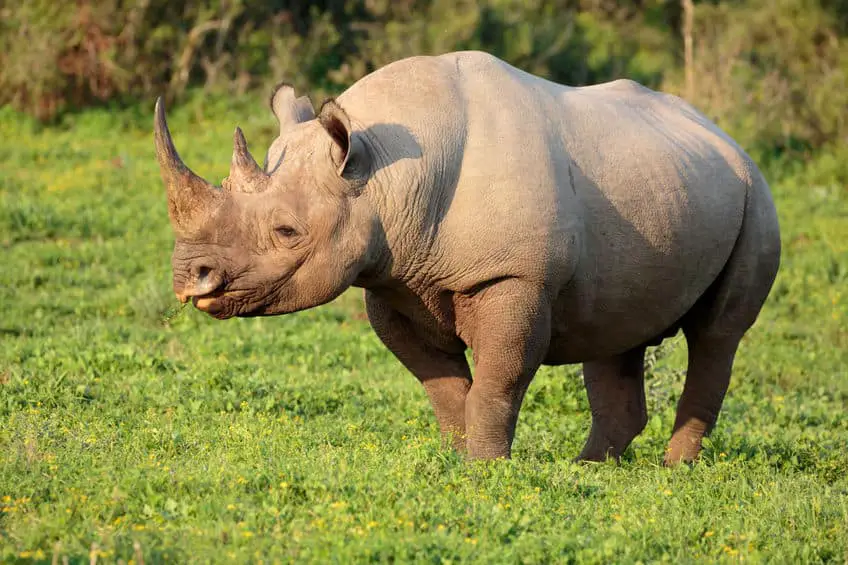
The black rhinoceros is one of the rarest large mammals in Africa and you have to be in the right place at the right time and either extremely lucky or skilled to see one. Black rhinoceros are just as fascinating as they are rare and in this post, I have collected 34 of the most interesting and surprising facts about them.
Facts About Black Rhinoceros Appearance And Personality
- Black rhinoceros are known to be aggressive and have unpredictable personalities.
- Black rhinoceros are about half the size of white rhinoceros.
- Black rhinoceros have a hooked upper lip. This is one of the easiest ways to tell them apart from white rhinoceros who have a wide, flat mouth. (Read more).
- Black rhinoceros have a smaller and shorter head than white rhinoceros.
- Black rhinoceros have small, round ears.
- Black rhinoceros have 2 horns. The front horn is larger than the other horn but the difference is not as significant as with the white rhino, whose front horn is much larger than its other horn.
- Black rhinoceros weighs between 1,550 to 3,100 lb (about 700 to 1,400 kg). (Read more).
- Black rhinoceros measures 4.6 to 5.9 ft (1.4 to 1.8 m) in height and 9.2 to 12.5 ft (2.8 to 3.8 m) in length.
- Black rhinoceros’ tails measure about 2 feet (about 60 cm) in length.
General Facts About Black Rhinoceros
- The scientific name of black rhinoceros is Diceros bicornis.
- Black rhinoceros belong to the Rhinocerotidae family of animals.
- Unlike its white cousin, the black rhinoceros is a solitary animal that lives on its own. They only seek out other black rhinos during mating season.
- Female black rhinoceros can occasionally get together and form temporary groups or even adopt calves that have been abandoned or lost their mother.
- A group of rhinoceros is called a crash.
- Black rhinoceros can run up to 34 mph (55 kph).
Facts About Black Rhinoceros Life Cycle
- The gestation period of female black rhinoceros is 14-15.5 months.
- Female black rhinoceros give birth to 1 calf at a time.
- At birth, a black rhinoceros calf weighs 66 to 99 pounds (30 to 45 kg).
- Calves stay with their mother for 2-3 years.
- The lifespan of black rhinoceros is 50 years in nature and 45 years in captivity.
Facts About Black Rhinoceros Habitat And Diet
- Black rhinoceros are very rare but can be seen in most of sub-Saharan Africa.
- The largest populations of black rhinoceros are found in South Africa, Namibia, Kenya, and Zimbabwe.
- The primary habitats of black rhinoceros are savanna, desert, and shrubland. (Read more).
- Black rhinoceros mostly eat leaves, branches, twigs, berries, and fruits.
- Black rhinoceros can eat over 100 different types of plants. They have an extremely strong stomach and can actually eat some poisonous plants that almost all other herbivores stay away from.
- You can tell black and white rhinoceros apart by looking at their dung. White rhinoceros eat grass almost exclusively and black rhinoceros have a much broader diet so their dung will have small, broken branches and twigs in it.
Facts About Black Rhinoceros’ Natural Enemies
- Black rhinoceros do not have many natural enemies due to their size, their dangerous horns, and their thick skin.
- Rhinoceros have extremely thick skin. It is 0.8 inches (20 mm) thick on the shoulders and 2 inches (50 mm) thick on the forehead. The thick skin provides excellent protection from predators since it is difficult to penetrate even with sharp claws and teeth.
- Lions often hunt as a group and when enough lions hunt together, they can hunt and kill black rhinoceros.
- Black rhinoceros calves are at higher risk of being preyed on than adults since they are smaller and easier to hunt.
- Crocodiles may sometimes try to snap a black rhinoceros calf if the opportunity strikes.
Facts About Black Rhinoceros Conservation
- There are significantly fewer black rhinoceros left in the wild than white rhinoceros.
- The conservation status of black rhinoceros is critically endangered.
- According to IUCN, there are estimated to be 3,142 black rhinoceros left in the wild in Africa.
Rhinoceros are completely mesmerizing creatures and in the right surroundings, they look almost like prehistoric animals or dinosaurs. Take a look at this page where you can find all our posts about black and white rhinoceros in which we dive much deeper into some of the facts listed in this post.
I hope you enjoyed reading this post about the big five of Africa. If you are interested in reading more about Cape buffalos, elephants, leopards, lions, or rhinoceros, you can click on these links to find all our posts about them in which we dive much deeper into many of the facts listed here.

